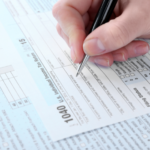Applicability of TDS on Sale of Property by NRI –
Whenever any property is purchased/sold, TDS is required to be deducted. The buyer when paying the amount to the seller will deduct TDS & pay the balance to the seller. TDS which has been deducted by the buyer would then be required to be deposited with the Income Tax Department by the buyer.
TDS to be deducted would be depend on the residential status of the seller. In case the Seller is a Resident Indian – the amount of TDS to be deducted would be 1% of Sale Price, only if the value of actual sales consideration exceeds Rs 50 Lakhs, whereas in case the Seller is a NRI – the amount of TDS to be deducted would depend on the quantum of money received by the seller irrespective of the Transaction Value of the Property.
The residential status of the buyer would not be considered and only the residential status of the seller would be considered for computing the amount of TDS to be deducted.
Rate of TDS on Sale of Property by NRI –
TDS on Sale of Property by NRI is required to be deducted as per the rates mentioned below:
In case of Long Term Capital Gains (LTCG) – Period of Holding – Property held for more than 2 years, TDS Rate on Sale of Property by NRI will be 20%.
In case of Short Term Capital Gains (STCG) – Period of Holding – Property held for less than 2 years, TDS Rate on Sale of Property by NRI will be as per Income Tax Slab Rates of Seller.
Note– Surcharge (If any) and Health & Education Cess (always) would also be levied on the above amount since the assessee is an NRI & In case of NRI Health & Education Cess @ 4% is always applicable.
Hence, the effective rate of TDS on sale of property by NRI in case of LTCG would be as follows:
| Particulars | Property Sale Price (Rs.) | ||||
| Less than 50 Lakhs | 50 Lakhs to 1 Crores | 1 Crore to 2 Crores | 2 Crore to 5 Crores | Above 5 Crores | |
| Long Term Capital Gains Tax | 20% | 20% | 20% | 20% | 20% |
| Add: Surcharge | Nil | 10% of above | 15% of above | 25% of above | 37% of above |
| Total Tax (including Surcharge)
|
20% | 22% | 23% | 25% | 27.4% |
| Add: Health & Education Cess | 4% | 4% | 4% | 4% | 4% |
| Applicable TDS Rate (including Surcharge & Cess) |
20.80% | 22.88% | 23.92% | 26% | 28.496% |
Important Notes:-
a) In case of STCG (i.e. if Property has been held for less than 2 years by the seller), this Surcharge and Cess would be added to the applicable Tax Rate as per the Income Tax Slabs in the same manner as explained above for LTCG.
b) This TDS is required to be deducted whenever any payment is made to the NRI for purchase of property. Even if any advance is being paid for purchase of property – TDS is required to be deducted.
c) This TDS is required to be deposited by the buyer with the Income Tax Department stating that this is the TDS which he has deducted from the payment made to NRI on purchase of immovable property.
d) This TDS on purchase of Property from NRI is required to be deducted irrespective of the Transaction Value of the Property. Even if the value of property is less than Rs. 50 Lakhs, TDS is required to be deducted.
Amount on which the TDS is required to be deducted –
(1). TDS on sale of property by NRI is required to be deducted under Section 195 & is ideally required to be deducted on the Capital Gains. However, this computation of Capital Gains cannot be done by the Seller himself and should be done by the Income Tax Officer.
(2). Seller shall file an application in Form-13 with the IT Department & request them to compute his Capital Gains. The procedure for filing of this form is a bit complicated & the seller can take the services of a chartered accountant for filing an application with the IT Department. Several documents like Purchase Price, Date of Purchase, any expenses on Renovation/ Construction etc. would be required to be submitted along with the Form 13. The Income Tax Officer will review these documents and if he is satisfied, he will issue a certificate for lower deduction of TDS.
(3). In case there are 2 sellers (i.e. Co-owners), both of them would be required to file Form 13 separately for reducing the TDS Rates.
(4). The IT Department will compute the Capital Gains of the seller & will issue a certificate for Nil/ Lower deduction of TDS depending on the capital gains arising on the sale of property.
(5). Provisions of lower TDS Certificate apply to both NRI’s as well as OCI Card holders and OCI card holders can also avail the benefit in the same manner.
(6). The seller is required to give this certificate to the buyer & the buyer will deduct the TDS as per the rates mentioned in the income tax certificate.
(7). In case this certificate is not obtained by the seller from the IT Department, the TDS should be deducted on the Total Sale Price & not on the Capital Gains. Therefore, it is very important for the seller to obtain this certificate from the Income Tax Officer.
(8). In case Seller does not opt for this certificate, he can also apply for Refund of the excess TDS deducted at the end of the year.
(9). Seller can reduce his Capital Gains which will lead to lesser TDS and Tax Liability if the seller intends to reinvests the capital gain in India.
(10). The details of the TDS deducted shall be mentioned in Property Sale Agreement. It is not the responsibility of the Property Registrar to ensure the TDS Deduction. The Registrar will register the Sale Agreement even if the TDS is not deducted or wrongly deducted.
(10). If the TDS is wrongly deducted or not deducted, the IT Department will not do anything to the seller but will catch hold of the buyer of property to deposit the TDS. If the buyer forgot to deduct the TDS or deducted less TDS – IT Department will recover the TDS from the buyer.
Procedure of TDS Payment, TDS Return & TAN No. –
(1). Lot of compliances to be taken care of when buying a property from a NRI. The buyer should have a TAN No. for deduction of TDS. TAN No. is not required in case property is purchased from a Resident Indian but is mandatory in case the property is purchased from a Non-Resident Indian.
(2). TAN No. stands for Tax Deduction and Collection Account Number & is different from a PAN Number. Only the buyer is required to have this TAN No. & not the seller. In case the buyer does not have the TAN No., he should apply for the same before deduction of TDS. It is important to note here that in case there are 2 buyers, both of them would be required to apply for a TAN No.
(3). Buyer should deduct TDS at the time of each payment and not at the time of Registration of Property
(4). TDS so deducted by the buyer shall be deposited with the IT Department within 7 days from the end of the month in which the TDS has been deducted. For example: If TDS is deducted in the month of June, then the TDS should be deposited with the IT Department on or before 7th July.
(5). This TDS is required to be deposited along with Challan No./ ITNS 281 & can be deposited online as well as through various bank branches.
(6). In case of late payment of TDS – interest would be levied @ 1%/1.5% per month on late deduction & late deposit of TDS after the specified date mentioned. In case of late filing of TDS Return – Penalty of Rs. 200 per day would be levied. The Income Tax Officer may also levy a penalty of upto Rs. 1 Lakhs.
(7). In case of Home Loan, TDS is to be deducted when payment is made to the Seller and not when the EMI is paid to the Bank. TDS would be deducted on advance payments as well.
(8). After the deposit of TDS, the buyer is required to furnish a TDS Return. This TDS Return is required to be furnished in Form 27Q & is required to be furnished separately for each quarter in which the TDS has been deducted. This TDS Return is required to be filed within 31 days from the end of the quarter in which the TDS has been deducted.
(9). After the deposit of TDS & filing of TDS Return, the buyer is also required to furnish Form – 16A to the seller of property.
Determining whether the Seller is a Resident or a Non-Resident –
(i). Residential Status of the Seller is an important thing to be done while doing a property transaction with NRI as the Rate of TDS to be deducted depends on whether the seller is a Resident in India or a NRI in India for Income tax purposes. It is on the basis of the no. of days which a person spends in India that it is determined whether the Seller is Resident in India or is a Non-Resident Indian.
(ii). Even if the Seller has Indian Aadhaar Card and PAN Card, he can still be considered as a Non-Resident in India. The Residential Status is determined only on the basis of no. of days spent in India and not on the basis of Aadhaar Card or PAN Card. The type of bank account of the seller also does not make any impact on the Residential Status of the Seller. Merely because a person has not converted his resident savings account to NRI Bank Accounts, he can still be considered as a Non-Resident.
(iii). The main benefit of becoming a Non-Resident is that the Income earned by a NRI from outside India is not taxable in India. However, foreign income earned by a Resident from outside India is taxable in India.
(iv). The main reason why people residing outside India try to maintain their NRI Status because if they become a Resident in India, they will have to pay tax in India on the Income earned from outside India as well.
Disclaimer: The information contained in this website is provided for informational purposes only, and should not be construed as legal/official advice on any matter. All the instructions, references, content, or documents are for educational purposes only and do not constitute legal advice. We do not accept any liabilities whatsoever for any losses caused directly or indirectly by the use/reliance of any information contained in this article or for any conclusion of the information.









